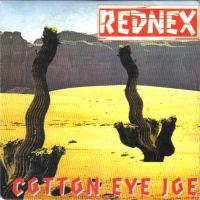
A large proportion of the European music that ends up in the UK chart is generally a bit cheesy and tacky, but nonetheless catchy, however music from Sweden is perhaps among some of the best. Neneh Cherry, Roxette, The Cardigans, Zara Larsson and, of course, Abba are some good examples, but in 1995 the novelty act Rednex gave us their interpretation of Cotton Eye Joe which has stood the test of time as it’s still well received at parties over 20 years later. If you search around the internet many have tried to understand what the song is about and suggestions range from a cowboy to a tailor to a sexually transmitted disease, let’s find out the truth.
Rednex were initially as bunch of Swedish producers who, in 1994, came together for the sole purpose of recording and releasing the track in a Euro-dance version. When this song became an unexpected hit, they had to bring in performers to front it and called themselves Rednex as a play on word Redneck which is a slang term for an old southerner in the States. The initial line-up were lead singer Mary Joe (b: Annika Ljungberg), violinists Billy Ray (b: Jonas Nilsson) and Bobby Sue (b: Kent Olander), banjo player Ken Tacky (b: Arne Arstrand) and bass drummer Mup (b: Patrick Edenberg), but over the last 25 years they have had almost 30 different members.
From the outset, I’ll tell you now there is no definitive story of the origins of this song but it goes back a long long way. According to an article written by Kenneth Partridge, The first known published version appeared in Alabama writer Louise Clarke Pyrnelle’s 1882 novel Diddie, Dumps, and Tot, or Plantation Child-Life, a nostalgic look at the antebellum South. Drawing heavily on her own childhood experiences on her father’s plantation, the novel gives credence to what most experts now hold as fact: “Cotton-Eyed Joe” originated with black slaves well before the Civil War. Pyrnelle’s version describes the titular character as an ugly man saying that ‘His eyes wuz crossed, an’ his nose wuz flat, an’ his teef wuz out,’ who swoops into town and steals the protagonist’s sweetheart.
According to Dorothy Scarborough, the Texas-born folklorist, the ballad is “an authentic slavery-time song,” predating the Civil War. In her ledger On The Trail Of Negro Folk Songs, published in 1925, she explains, “The air and some of the words were given by my sister, Mrs. George Scarborough, as learned from the Negroes on a plantation in Texas, and other parts by an old man in Louisiana, who sang it to the same tune. He said he had known it from his earliest childhood and had heard the slaves sing it on plantations.”
Whatever the origins the song it soon became a square dance and quickly spread throughout the Deep South of America. The earliest known recorded version of the song was in 1927 as recorded by the string band Dykes Magic City Trio, but with that said, the trio’s leader John Dykes claimed he learned it from a Kenner C. Karchtner a fiddler who originated from Arizona who, in turn, said he picked it up in Mississippi at the end of the 19th century from a man named Youngblood.
According to one archive there have been more than 130 recorded versions since 1950 including versions by the unlikely named acts Gid Tanner & The Skillet Lickers (1928), Adolph Hofner & His San Antonians (1941) and Bob Wills & His Texas Playboys (1946). Among the more well-known names, Nina Simone (1959), Terry Callier (1964), The Chieftains (1981), Michelle Shocked (1992) and, wait for it, the Crazy Frog in 2006.
Cotton Eye Joe, apart from making number one in the UK, also topped the chart in Austria, Sweden, Switzerland, Germany, Netherlands, Norway and Finland. Rednex had further UK hits, believe it or not, with Old Pop in an Oak (12) and Wild ‘n Free (55), which gives little indication of their popularity on the Continent. Wish You Were Here and Spirit of the Hawk were number one in Germany and their album Sex And Violins was a big European seller. In 2002, they released a greatest hits called The Best of the West.
Original members Billy Ray and Mup are still in the group and they still tour regularly and the ever-changing line-up includes such interestingly-named personnel such as Dagger, Bone Duster Crock, Ace Ratclaw and Pervis the Palergator.
Love it or hate, but this version continues to be a big favourite at various sports arenas and weddings across the country.